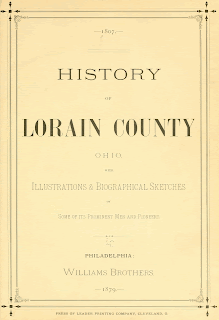- "DIED, at Grafton, Ohio, on the 5th of August last, Mr. Jesse Taylor, formerly of this town, and son of Mr. James Taylor, aged 42. --On the 21st of August, Mrs. Lucy Taylor, his wife, aged 41."
The 1820 US Census taken in Grafton, Medina County (later becoming Lorain County in 1828), lists a household identical to the one described above with the added person of an additional free white male of 26-44 years of age. This was Josiah W. Taylor, who, records tell us married Emeline Jones at Grafton on March 1, 1822. See Josiah W. Taylor marriage certificate 1822
I am pleased to be able to share another piece of the puzzle to the early Taylor history in Ohio. This week I discovered the 1824-1828 handling of Jesse Taylor's estate by his brother Josiah W. Taylor, who the Medina County Court of Common Pleas had appointed the administrator of his estate. Among other things, this document lists Jesse's surviving children (once again BFT's name is given as Franklin), makes no mention of his wife Lucy, who was deceased a little over one month from when these proceedings began (Sept. 27, 1824), gives a list of Jesse's physical possessions at the time of his death, lists the names of creditors and all of his debts, and gives the exact location of his 9-acre plot at lot #90 on the west side of Grafton Township. Another interesting piece of information this document provides the name of Jesse's physician, Doctor M. H. Manter (see bio at: W. H. Manter, MD) who collected debts from the estate, which were quite sizable when you consider that the debt collected of $48 amounts to 27% of the entire estate (not including land holdings). From this information, I am pretty comfortable with the deduction that Jesse and Lucy Taylor died of some type of prolonged illness which required multiple visits from their doctor, Doctor Manter, who lived in the county seat of Elyria just to the northwest.
One final wrinkle is the realization that by the time these proceedings started, Franklin had turned 19, but was still not considered an adult in terms of property or the law. Aaron Root (who was paid $11.80 by the estate) is the court's named guardian ad litem for the children of Jesse and Lucy Taylor, and it appears that there was no dispute raised to Josiah W. Taylor's liquidation and settling of the estate. One last note is that Josiah's father-in-law, Eliphalet Jones, was named as one of three appraisers by the court who provided values on the final inventory of the estate, and he was also a creditor, leaving at least some room for believing that there might have been a shade of conflict of interest there (though in fairness each of the other two appraisers were also creditors paid by the estate). The back taxes paid to the county on the estate was $4.79. The final amount raised from the liquidation of the estate was $264.68 1/2, of which it appears that $290.70 was paid out to creditors. Now I am not sure exactly how that math works. Did Jesse's brother Josiah pay creditors out of pocket for the additional debts incurred? There is no record that any of Jesse and Lucy's children benefitted whatsoever from the sale of the estate, though I'm sure that their interests were represented by the court. I will post this and share with legal experts from the family to gain better understanding and revisit this question if and when more information is learned. To one who is less learned such as I, it appears that the untimely demise of a young couple such as this presented an overwhelming urge to profit from it to many members of the community. Nearly two hundred years later, I am judging this with modern-day sensibilities, but it is just hard to examine these documents and think anything else. I am shocked that Jesse would have died owing so much to so many people in the community, when today that would definitely not be the case. However, in the early nineteenth century it was probably common to incur private debts in communities that did not even have operating banks or other financial institutions.
Here is the link for your viewing: Jesse Taylor Estate 1824-28 Court Records
The map below shows Grafton in Lorain County and it's close proximity to Historical LDS locations at Amherst and Russia townships. The center of Grafton Township is Belden where our ancestors are buried. Belden is approximately 55 miles from Kirtland, Ohio, just 32 miles southwest of Cleveland:





